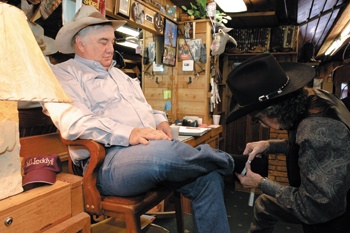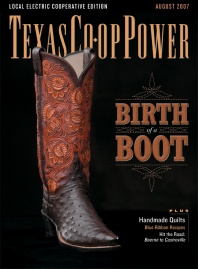Pete Bonds can remember when he took out his first loan to buy cattle (he was 16), but he can’t remember when he ordered his first custom-made pair from legendary bootmaker M.L. Leddy’s. “As a kid, I never went barefoot,” he explains, settling himself into the elevated fitting chair at the landmark store on North Main in Fort Worth’s Stockyards Historic District. “I have real tender feet and ill-shaped toes. Leddy’s boots fit well, and they hold up.”
Throughout its 85-year history, Leddy’s has been owned and run by the same family. In 1918, M.L. Leddy left his parents’ cotton farm to work for a saddle and bootmaking business in the little West Texas town of Brady. He bought the business in 1922, then moved it 50 miles west to San Angelo in 1936. He opened his flagship store in the booming Fort Worth Stockyards in 1941.
To get from the front of the store to the boot department, customers have to pass through two rooms of high-end Western wear, hand-tooled belts and saddles, and cases displaying silver and gold belt buckles. But Pete Bonds isn’t distracted. He is here for one thing: to order a pair of what many ranchers, farmers, oilmen, barrel racers and cutting-horse champions—not to mention lawyers, surgeons, car dealers and football coaches—consider the best boots in Texas.
At 55, Bonds is physically substantial, well over 6 feet tall and sturdy. He wears a once cream-colored, sweat-stained cowboy hat with four toothpicks tucked strategically in the band. His operation has grown from 400 cows in 1968 to 8,000 head grazing from Uvalde, Texas, to Creighton, Nebraska. Spreading his ranches north to south offers a hedge against untoward meteorological events; a blizzard or a tornado might hurt, but it won’t wipe him out. At his main place west of Fort Worth, he gets his electricity from Tri-County Electric Co-op.
Boot-fitter Gene Reynolds shakes Bonds’ hand. “I bet it’s been five years since I’ve seen you,” he says.
“That’s how long a pair of Leddy’s boots lasts,” Bonds replies. Durability helps buffer the sticker shock. Although the company will make a pair for as little as $598, the average runs $1,100 to $1,300. Exotic leathers and fancy inlays can double or even triple the tab.
Reynolds, who resembles a lanky Old West sheriff, pulls off Bonds’ boots. They’re caramel-colored oil-tanned calf with red calfskin tops. Penned inside the top is Bonds’ customer number, corresponding to his entry in one of the tall ledgers that pack several bookcases. More than 2,500 pairs of sketched soles fill those pages. The customer books are arranged by geographic area: Fort Worth, Fredericksburg, Houston—even Las Vegas, where Leddy’s takes a booth at the National Finals Rodeo. Crowding a bookcase in a corner of the boot room are the oldest books, dating back to the 1940s. One contains only celebrities.
Reynolds takes down a customer book and opens it to a pair of pages featuring outlines of Bonds’ feet. As Bonds places first the right and then the left within the outline, Reynolds bends down to examine them. Unfurling a tape measure, he has Bonds cross his right leg over his left and wraps the tape around first the ball and then the instep of his foot.
Measuring is the most important part, Reynolds explains. It’s the reason customers are willing to wait 10 months for a pair of custom-made boots instead of choosing one of the couple of hundred ready-made pairs that line Leddy’s shelves. Some of these are elegantly plain black or brown calf, some are fashioned from ostrich or alligator, and some feature fancy inlays, such as white stars or pink roses on green stems. One pair in purple calf sports “TCU” on the right top and a ferocious-looking horned frog on the left. Because every pair of Leddy’s boots is handmade, off-the-shelf pairs cost the same as ones made to order.
To get an idea of the proper placement and height of the arch, Reynolds normally has a custom-fit customer try on several pairs off the shelf, but Bonds’ feet are too distinctive for that to be useful.
“I think that bunion might have grown a bit,” Reynolds observes. Bonds nods affirmatively. Reynolds continues: “How are the pair you’re wearing now doing for you? What you should feel in a pair of boots is nothing.”
“They feel fine,” Bonds reports. “But the pegs on the left one are loose.” Reynolds hands the boot to an assistant to reset the lemonwood pegs that fine bootmakers use on the arch to allow the boot to breathe.
Bonds places his order: He wants boots exactly like those he wore into the store. He prefers pull-holes to tabs, which can break when wet. He also likes the classic Leddy’s stitch pattern for the tops, parallel rows of white stitching forming feathery wings. Stitching looks pretty, but its main purpose is function: It helps the tops stand up, even when the boots are wet or worn. He gets a fairly tall heel, because he works on horseback. “I damn sure don’t want to get hung up,” he says.
“I almost always get the same boots,” Bonds explains. “For the first few years, they’re my dress boots. Then, when they get worn, they’re my work boots.” He carries two pairs of work boots in his truck—one for walking, the other, with the spurs already strapped on, for riding.
Despite his loyalty to oil-tanned calf, a ring of alligator samples catches Bonds’ eye. As he fingers the surprisingly soft reptile skins, he listens as Reynolds tells him that they’ve been tanned in Lafayette, Louisiana, using a French process. “A friend has invited me to come hunting on his place near Anahuac,” Bonds says. “When I get my gator, how much will you charge me to make it into a pair of boots?” About $1,000, Reynolds says, advising him to make it a big animal, so that the patterns in the hide will match up nicely.
Bonds’ boot order, with all its distinctive specs, goes to Leddy’s bootmaking facility in San Angelo. A thousand rolls of leather in more colors than a giant-sized box of Crayolas stuff shelves and cardboard bins—from oil-tanned calf for work boots to eel, alligator, Italian-tanned kangaroo and a butter-soft Texas sheepskin. Calf dominates, but close behind is ostrich, which has greater resistance to “barnyard acid,” a euphemism for the mix of manure and urine that cracks and digests leather.
Leddy’s completes only 10 pairs of boots a day, which explains the 10-month wait. Production manager Judy English, a trim woman with shoulder-length blond hair, oversees a process that hasn’t changed much in 85 years. Each of the 17 workers she supervises has a specific task, but this is no mechanized production line. The process begins with the slick wooden or plastic Leddy’s last, built out with fittings to accommodate individual differences, such as Bonds’ bunion. Famous for their arch support, all the basic lasts were designed by Arch Baird, one of the original Leddy’s bootmakers. The last is essential to each part of the process, for shaping and drying, so that every custom Leddy’s boot fits the individual customer’s feet.
One bootmaker cuts out the vamp, with the distinctive Leddy’s narrow triple-scallop tongue, and crimps it to give the boot shape and prevent stretching with wear. Another applies the single bug and wrinkle—the stitching that protects the leather from cracking when the toes flex—another hallmark of a Leddy’s boot. Another craftsman builds the soles, which another sets and still another trims. One of the most delicate procedures is inserting the only manmade components of a Leddy’s boot: lemonwood pegs (the wood comes from Germany) and tiny finishing nails, plus a 3-inch-long 40d common nail, essential to arch support, in the shank.
Working on an ancient-looking black Singer sewing machine, Maria Reyes, a dark-haired woman with the intense focus of an artist, produces the inlaid tops—Lone Star and U.S. flags, college and corporate logos, floral patterns worthy of a rodeo queen. Other seamstresses make the stitched tops, many with patterns that have been popular since before Bob Wills hit the airwaves in 1934.
Caressingly soft leather lining and an all-leather heel—tall for riding or medium for walking or dancing—complete the components. For the final step, the boots go to the finish room, which is separate from the main production room, to keep dust from interfering with the painstaking cleaning of all the crevices, sanding of the soles and polishing with Meltonian, a leather cream Leddy’s swears by.
Pink order slips bearing the names, numbers and specs of customers travel with each boot from start to finish. Affixed to one last, I notice a slip marked “Nolan Ryan.”
Officially, Leddy’s keeps customers’ names confidential, but San Angelo sales manager and unofficial company historian Sammy Farmer apparently takes “name” literally. “We’ve made boots for several presidents, including one that’s sitting now,” he says proudly. “And we just shipped a pair for the former president of Texas A&M. It’s got the Aggie logo and everything. He doesn’t want his feet to hurt up there in Washington.”
That would be Secretary of Defense Robert Gates.
When the finished boots arrive at the Fort Worth store, Leddy’s calls the customer, who’ll either come in or have them sent. Leddy’s has shipped boots as far as Switzerland, even to Kuwait City. Shipping is part of the service; and service, from measuring an instep to resetting loose pegs, is ultimately what sets a fine custom bootmaker apart.
Sandy Sheehy is author of Texas Big Rich and Connecting: The Enduring Power of Female Friendship.


